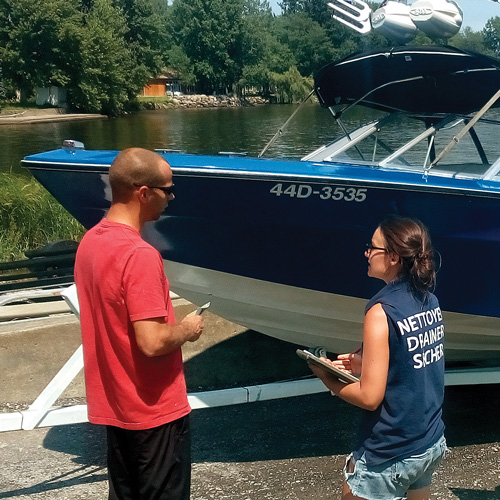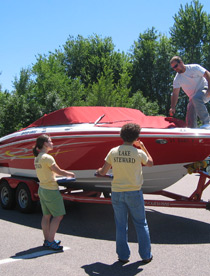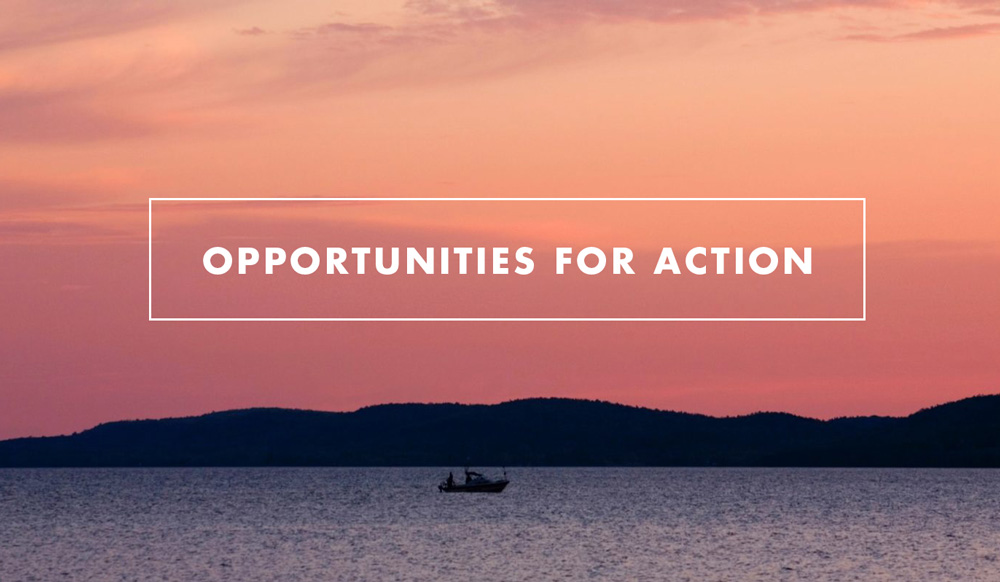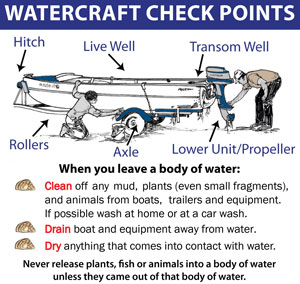AIS Spread Prevention

Once aquatic nuisance species are present in Lake Champlain, they are very difficult or even impossible to remove, and extremely costly to manage. Spread prevention relies on early detection of species and pathways of introduction, rapid response to new threats, and public education programs.
Close collaboration among stakeholders is critical to the dynamic nature of invasive species management in the Lake Champlain Basin. Public education and outreach and new laws and regulations that prohibit the transport of aquatic plants and certain invasive and nuisance species have been important management tools.
Partnerships
The LCBP works with a broad group of governmental, academic, not-for-profit, and commercial partners at the local, regional, and national levels to address aquatic invasive species. LCBP is a member of the Northeast Aquatic Nuisance Species (NEANS) Panel and the national Aquatic Nuisance Species Task Force. The NEANS Panel works to protect the marine and freshwater resources of the Northeast from aquatic invasive species. The group recently created an online tool that enables local organizations to print custom field guides that include species that are most relevant in their regions. The ANS Task Force is an intergovernmental organization that works at the national level to control AIS and implement the Nonindigenous Aquatic Nuisance Prevention and Control Act (NANPCA) of 1990 and the National Invasive Species Act (NISA) of 1996. The ANS Task Force includes links to taxonomic experts in each U.S. state.
Rapid Response Plan
In May 2009, the Lake Champlain Steering Committee approved the Lake Champlain Basin Rapid Response Action Plan for Aquatic Invasive Species. This plan is intended to ensure that appropriate protocols, trained personnel, equipment, permits, and other resources are in place to contain and potentially eradicate newly detected nonnative aquatic invasive species as they are reported in the Basin. Task Force members from Québec, New York, and Vermont have been appointed to respond to and oversee rapid response actions. The Plan is updated regularly by the LCBP Aquatic Nuisance Species Subcommittee and Rapid Response Workgroup.
- Rapid Response Task Force recommendation: Spiny waterflea Champlain Canal Summer 2012
- Rapid Response Task Force recommendation: Spiny waterflea Lake George Summer 2012
Champlain Canal
The Champlain Canal, which connects Lake Champlain to the Hudson River and Great Lakes watersheds, is an open pathway for transporting aquatic invasive species to Lake Champlain. With 122 known aquatic invasive species in the Hudson and 184 in the Great Lakes, these watersheds are sources of tremendous AIS threats. Many species, including the Asian clam, spiny waterflea, hydrilla, round goby, and quagga mussel, could potentially enter Lake Champlain through the Champlain Canal. In November, 2008 the LCBP, the NYS Canal Corporation, and several partner groups met to explore threats and solutions to the problem. LCBP continues to work with the NYS Canal Corporation and the US Army Corps of Engineers to conduct a Champlain Canal barrier feasibility study to prevent the spread of aquatic invasive species through the canal system.
- Champlain Canal Aquatic Invasive Species Stakeholder Meeting – Summary
- Champlain Canal Aquatic Invasive Species Stakeholder Meeting – Public Comments
Lake Stewards Program

Since 2007, the LCBP has supported the Lake Champlain Lake Steward program to inform the public about aquatic invasive species spread prevention. Stewards are stationed at high-use boat launches in Vermont and New York on Lake Champlain to offer courtesy boat inspections, remove aquatic plants and other organisms from boats, trailers and other recreational equipment, and gather boat launch user data. Stewards work from Memorial Day to Labor Day weekend for 3-4 days a week. The pilot program began in 2007 with four stewards and has grown to eight stewards.
NALMS 2013 Presentation: An Overview of the Lake Champlain Basin Boat Launch Steward Program
Lake Champlain Cooperative Boat Wash Program
The overland transport of boats, personal watercraft, fishing gear, and other aquatic equipment is a common means by aquatic invasive species (AIS) are spread between water bodies.

Pressure washing has been shown to be a very effective method for removing aquatic organisms of all life stages from boats and other equipment. The LCBP and its partners have organized the Lake Champlain Cooperative Boat Wash Program. The program has developed the Cooperative Boat Wash Program Map to help boaters find local car wash stations that are suitable for pressure washing boats, trailers, and other equipment. The program also helps provide boaters with the equipment necessary to properly clean their vessel and rid it of aquatic hitchhikers. To prevent the introduction of harmful invasive species into new waters, clean boats after use and/or before launching.
What You Can Do

Even if you are not greeted by a boat launch steward, or there are no boat wash stations near you, you can still help to prevent aquatic invasive species from hitchhiking on your boat:
- Clean off any mud, plants (even small fragments), and animals from boats, trailers and equipment.
- Drain boat and equipment away from water.
- Dry anything that comes into contact with water.
Learn how volunteers in the Adirondacks are helping survey backcountry ponds for aquatic invasive species in this video from our Diving In series.
More on AIS Spread Prevention
- No More Free Rides rack card English | French
- Voluntary Guidelines to Prevent the Introduction and Spread of Aquatic Invasive Species: Water Gardening
- Voluntary Guidelines to Prevent the Introduction and Spread of Aquatic Invasive Species: Recreational Activities
- Federal Register Notice: ANSTF Recreational / Water Gardening Guidelines Publication Date: 06-04-2014
- Classroom Guidelines for Preventing the Introduction and Spread of Aquatic Invasive Species (AIS)
- Boat Inspection and Decontamination for Aquatic Invasive Species Prevention – Recommendations for the Adirondack Region
- Lake Champlain Basin Aquatic Invasive Species Guide
- Aquatic Invaders Brochure (Spread Prevention Tips)
- Clean Boats Clean Tournaments project, University of Wisconsin Sea Grant.
- Baitfish of Vermont, Including Lake Champlain (VT FWD)
- New York Invasive Species Information (Cornell University Cooperative Extension and NY Sea Grant)


